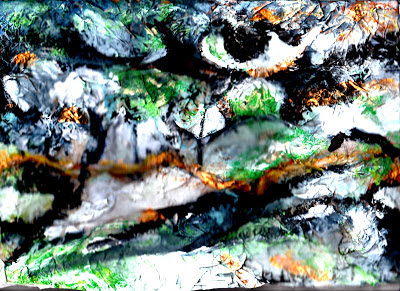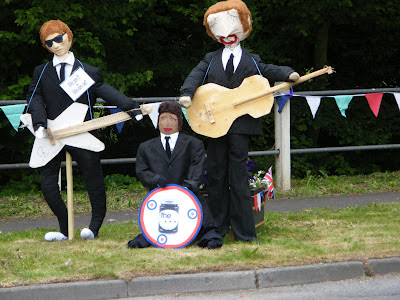Texture
This has been a lot of hard work and included a huge amount of stitching. I would have liked to have completed and shown more examples of use of stitching but have found it difficult to get myself sat at my machine. I think I have been worried about the final piece of stitching and working out how I was going to achieve a good result. Having said that I am very pleased with how it has turned out.
I have been very brave and joined my local branch of the Embroiderer's Guild (having joined the main Guild last year). I thought I should go to the local branch and at least have some contact with other people who embroider. I appear to be the only person who is not a hand embroiderer, so the practical sessions are a bit daunting! We have been asked to make a Christmas tree decoration for the Christmas Tree Festival at a Salisbury church. I haven't completed mine yet, but have stitched a small silver star in metallic silver ribbon (cable stitch - and yes it does look quite delicate for cable stitch). I shall applique this onto some red silk and stitch it all up with a red tassel and gold beads. So below is the work that has taken me three months to do - sorry!
Texture Resources (page 87 of Module 2)
Here are a few images of textural pictures, there are many more but could spend all day putting these on the blog. I particularly like the bark images, the dried sunflowers and the rose. I have added words to describe their texture on the pictures themselves.
 |
| papery, flaky, peeling, bovine, smooth, antler and metallic |
 |
| rough, ancient, craggy, dry, succulent, smooth, rubbery, round, knobbly |
 |
| papery, tissue like, scented, soft, delicate, feathery, spiky, tough |
 |
| rubbery, elegant, rough, bull dog teeth, octopus, tendrils and sharp |
 |
| rough, dry, pliable, lacy, fluffy and springy |
 |
| dry, papery, crispy, crumbly, smooth, |
Bridget Riley and Visual Texture (page 91 of Module 2)
Attempting to create an illusion of a 3D image was a lot more difficult than I expected. I did understand the principals and the need to plan and therefore stitch carefully in order to achieve the effect. However, after 2 attempts I wasn't very good at it, although I could see that after the second attempt I had got a little closer. I fully intended to have a third attempt after finishing this chapter but had lost the motivation.
 |
| Image of Bridget Riley's 'Current' 1964 |
 |
| First attempt at creating a 3D image |
 |
| A second attempt at recreating 3D image with black thread and white felt, using Bridget Riley's 'Current' (1964) as a resource. |
Experiments with Stitching Textures (page 92 of Module 2)
Below are some examples:
Mark Making to Create Visual Texture (page 93 of Module 2)
Although I tried to work quickly without thinking it was a little tricky, particularly trying to capture the shape of smell of a red rose! Results below!
 |
| These two images are of a cacoon of vine leaves and scrunching through frost. All make with black charcoal. The scrunch of the frost is made with a bottle cleaning brush. |
 |
The marks were made with black charcoal and stitched on calico with the same for a stabiliser. Using free embroidery I stitched zig zag vermicelli with a black metallic thread, and then overstitched with an automatic pattern vermicelli style. The central red square was overstiched in red and an automatic pattern. I thought of the red square at the last minute and represents a trapped person.
|
 |
| Using black charcoal to make the marks, I stitched the shapes onto a piece of deep pink felt (white felt for stabiliser) using a thick silky piece of thread, in cable stitch. I hoped to capture the idea of scent by using swirls of stitches. |
 |
To make the marks I used a black charcoal pencil on cartridge paper. The stitching is on white felt using the same as a stabiliser. I used free embroidery beginning with a green whip stitch to create a feeling of coolness and flow of air. For some reason I used a purple zig zag vermicelli over the green stitching, though I don't know why, because it hasn't added anything to it.
|
Creating Texture with Paper and Glue (page 93 of Module 2)
I took this picture of tree bark at Savernack Forest near Marlborough Wiltshire on a very wet Wednesday morning and used this as a source for creating texture with fabric and stitch.
 |
Original photo of tree bark (my own photo)
|
The image below shows how I built up layers of tissue with PVA to try to mould. the tissue to represent the photograph of bark. I found the tissue difficult to mould as it kept breaking up and dissolving into nothing. The size of the tissue model is A4.
 |
| Original photo of tree bark with tissue model. |
After drying out the tissue was then painted with acrylic paint. I began to realise that the A4 size would be too large to stitch so decided to take a scan of the model and reduce it to A5.
 | ||
Painted tissue
|
 |
Selection of threads I have finally chosen. They mainly consist of crewel embroidery wool with some embroidery silk and cotton. I have found crewel embroidery thread very satisfying to work with.
|
I tacked an area the size of the scanned A5 image that I have worked from onto a piece of black felt. Using stitch and tear I traced around some of the shapes on the scanned image. As I had planned to use cable stitch and free embroidery I marked these areas from the back of the felt with a white thread.

Base piece of felt with low relief areas stitched in cable stitch, the white stitching marking the outline of the high relief areas can be seen also. Finished piece of work below.
|
Finished piece of work. I began to realise that I still had too large an area to stitch so decided to limit the high relief pieces to six pieces of stitched black felt. These were stitched on over the marked areas by hand. The stitches used were chiefly cable stitch using free machine embroidery with straight stitch and some zig zag. I also used some cable stitched granite stitch continuing to use thicker thread in the bobbin, with some conventional granite stitch on top using a 40 thread thickness. I decided against using Kunin felt and a heat gun until I had experimented more and felt confident I wasn't going to burn away all my hard work.
Although this chapter has been hard work in all sorts of ways, I am very pleased with how it has turned out. When I first thought about it all I thought I was going to create a very natural looking representation of the bark and collected threads of a naturalistic colour. In the event it has turned out very different to how I envisaged, maybe David Hockney has had a slight influence.
|





































